
Valencia is the capital of the autonomous community of Valencia and the third-most populated municipality in Spain, with 791,413 inhabitants. It is the capital of the province of the same name. The wider urban area comprising the neighbouring municipalities has a population of around 1.6 million, constituting one of the major urban areas on the European side of the Mediterranean Sea. It is located on the banks of the Turia, on the east coast of the Iberian Peninsula, at the Gulf of Valencia, north of the Albufera lagoon.
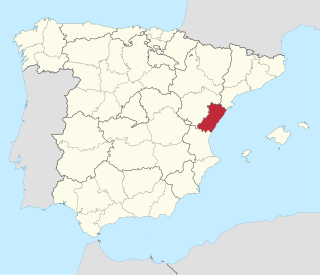
Castellón is a province in the northern part of the Valencian Community. It is bordered by the provinces of Valencia to the south, Teruel to the west, Tarragona to the north, and by the Mediterranean Sea to the east. The western side of the province is in the mountainous Sistema Ibérico area.

Gandia is a city and municipality in the Valencian Community, eastern Spain on the Mediterranean. Gandia is located on the Costa del Azahar, 65 kilometres (40 mi) south of Valencia and 110 km (68 mi) north of Alicante. Vehicles can access the city through road N-332.
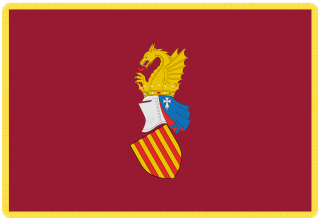
The Generalitat Valenciana is the generic name covering the different self-government institutions under which the Spanish autonomous community of Valencia is politically organized.
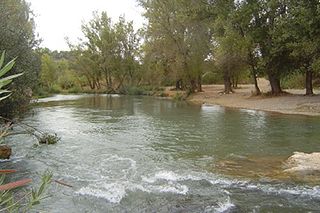
The Turia or Túria is a river in Spain, which has its source in the Montes Universales in the mountain ranges of the northwesternmost end of the Sistema Ibérico, Teruel province. From its source to roughly the city of Teruel, it is called Guadalaviar river. It runs through the provinces of Teruel, Cuenca and Valencia, and discharges into the Mediterranean Sea near the city of Valencia. The river formerly ran through the center of the city but was diverted south of the city to prevent flooding.
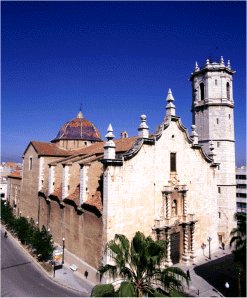
Benicarló is a city and municipality in the north of the province of Castelló, part of the Valencian Community, in the Mediterranean Coast between the cities of Vinaròs and Peníscola, not too far south from the Ebre River.

Costa del Azahar or Costa dels Tarongers is the name for the coast of the province of Castellón in Spain, from Vinaròs to Almenara.
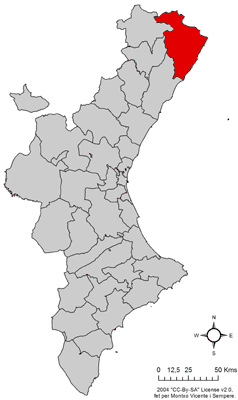
Baix Maestrat is a coastal comarca located in the north of the province of Castellón, Valencian Community, Spain. The capital of the comarca is Vinaròs.

Palau de les Arts Reina Sofía is an opera house, performing arts centre, and urban landmark designed by Santiago Calatrava to anchor the northwest end of the City of Arts and Sciences in Valencia, Spain. It opened on 8 October 2005; its first opera staging was of Beethoven's Fidelio on 25 October 2006. Tenor and conductor Plácido Domingo has maintained a special relationship with the Palau since its founding and has established a young singers training program there.

The Corts Valencianes, commonly known as Les Corts, are the main legislative body of the Generalitat Valenciana and therefore of the Valencian Community. The main location of the Corts is in the Palace of the Borgias in Valencia; however it can meet at any location in the Valencian lands. The Corts has its origins in bodies established in the thirteenth century by King James I of Aragon. The modern institution was established in 1982 under the Valencian statute of autonomy of 1982. The current Corts were elected in 2019.

The Route of the Borgias is a cultural route, that includes sites associated with the Borja or Borgia, located in their native Valencian Community, Spain. The marketing of the route was inaugurated in 2007.
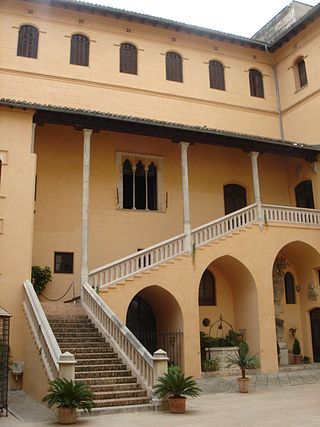
The Ducal Palace of Gandia was, from the 14th century, the residence of the Royal Dukes of Gandía, and from 1485, the Borja family. It was the birthplace of Saint Francis Borja.

The Tower and walls of the Borgias of the Valencian municipality of Canals (Spain), is a Bien de Interés Cultural with the code 46.23.081-003 and Ministerial annotation R-I-51-0010524 with date April 3, 2000. Is also known in valencian as Torreta de Canals.
The Hermitage of Santa Anna is a religious building located in the surroundings of Xàtiva (València), Spain, built in the 15th century.

The Oratory of the Borgias or Church of the Tower is located in the municipality of Canals (Valencia), Spain. It is a church built in early Valencian Gothic style, probably in the 13th century.

The Route of the Valencian classics,, is a cultural route through the lands of the great classical writers of the Valencian literature of the Valencian Golden Age: Ausiàs March, Joanot Martorell and Joan Roís de Corella, the three related to the court of the Duke Alfonso of Aragon and Foix, "the Old".
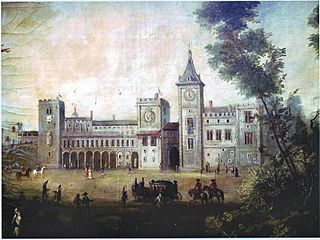
The now vanished Del Real Palace or Royal Palace was the former residence of the kings of Valencia in the «Cap i Casal» of the Kingdom, as the city of Valencia was then called. It was on the left bank of the Turia River, where nowadays Jardines del Real are. It was also known as «300 keys palace» in reference to the number of rooms it had in its heights.

Valencian Gothic is an architectural style. It occurred under the Kingdom of Valencia between the 13th and 15th centuries, which places it at the end of the European Gothic period and at the beginning of the Renaissance. The term "Valencian Gothic" is confined to the Kingdom of Valencia and its area of influence, which has its own characteristics.

The Palacio de Ripalda was a building of Eclectic style designed in 1889 by Spanish architect Joaquín María Arnau Miramón in the Spanish city of Valencia.

Valencia is one of the three constituencies represented in the Corts Valencianes, the regional legislature of the Valencian Community. The constituency currently elects 40 deputies. Its boundaries correspond to those of the Spanish province of Valencia. The electoral system uses the D'Hondt method and a closed-list proportional representation, with a minimum threshold of five percent regionally.



















